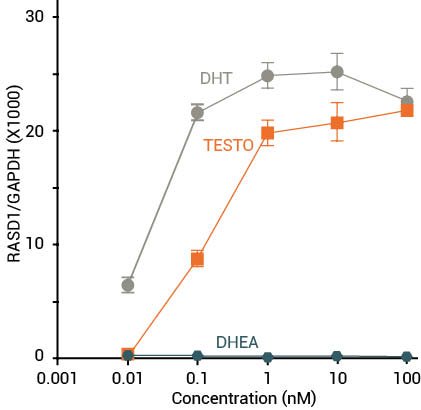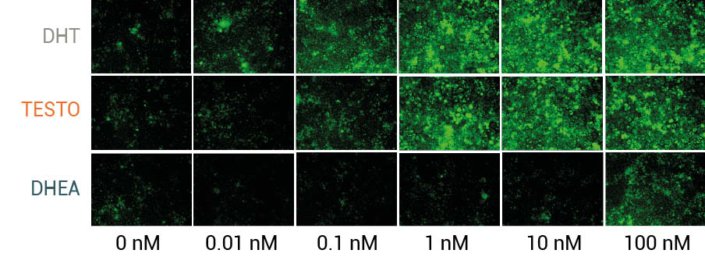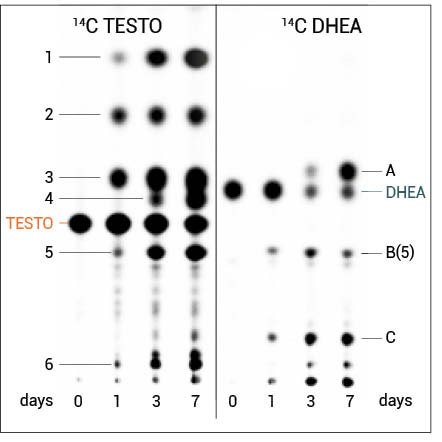1 – Exogenous androgens (TESTO, DHEA) & DHT activity
2 – Exogenous androgens (TESTO, DHEA) metabolism & activity
CONCLUSIONS
In this model,
– TESTO is an active androgen by itself and is converted into DHT through the activity of type 1 5-alpha reductase. DHT direct androgenic activity is achieved at concentrations 10-fold lower than TESTO. Other metabolites are also formed such as –dione metabolites which exhibit a low but significant androgenic activity (> 10-fold less active than TESTO).
– DHEA is totally inactive by itself. It is not transformed into TESTO and 3bHSD expression was not detected. DHEA is very slowly metabolized into androsterone and other discrete species. Androsterone is moderately active by itself (> 10-fold less active than TESTO) and could explain the low activity of DHEA in long term assays.
– An excess of DHEA did not interfere with Testo metabolism and DHT production, nor with the androgenic activity of DHT, thus it cannot be considered as a “competitor” of TESTO.
REFERENCES
1 Barrault et al. (2015) J Steroid Biochem Mol Biol ;152:34-44
2 Bernard et al. (2000) Int J Cosmet Sci ;22:397-407










Behavior of the two circulating androgens testosterone and DHEA and their main intracellular metabolites in an androgen-sensitive sebocyte cell line.
Acné, Sebaceous gland regulationAndrogens are known to strongly regulate the sebaceous gland. Relationships with testosterone have been reported and little is known about the role of DHEA. We showed that the most potent intracellular androgen metabolite, dihydrotestosterone (DHT), induced AR translocation, specific transcripts such as ras-related dexamethasone induced 1 (RASD1) and lipogenesis/lipid storage. We used these parameters to assess the behaviour and activity of the two main circulating androgens TESTO and DHEA, in comparison with DHT, in this model.
Innate immunity activation of sebocyte cells by living bacteria. Evidence of a potential immunosuppressive effect of DHT.
Acné, Acné, Microbiome cutané, Microbiome cutané, Microbiome cutané, Sebaceous gland regulationAcne is a skin pathology targeting the pilosebaceous unit…sebum hypersecretion and bacterial infection. We studied the effects of living bacteria on the induction of an innate immune response in a sebocyte cell line.
Pharmacological effects of anti-androgens and other compounds in an androgen-sensitive sebocyte cell line.
Acné, Acné, Sebaceous gland regulationWe analysed the activity of reference anti-androgens (Finasteride, Dutasteride, Cyproterone acetate), at the level of their potential targets (5-alpha-reductase, AR translocation, induced transcripts) and in a functional lipid accumulation assay. We also evaluated this androgen-induced lipid accumulation assay as a potential pharmacological tool to detect potential inhibitors from both androgenic and non-androgenic origins.
Androgens activate lipogenesis through an AKT-independent mTOR pathway stimulation and a limitation of autophagy in an androgen-sensitive sebocyte cell line.
Acné, Acné, Peau grasse, hyperséborrhée et séborégulation, Sebaceous gland regulationAndrogens are key regulators of sebaceous function… A link between mTOR and androgen signaling has previously been reported…as well as a link between these processes and lipid synthesis…Here we aimed at confirming that DHT-induced lipid synthesis/accumulation is at least in part dependent on mTOR activation in the SEBO662AR cell line and that the autophagic process is consequently modified by the androgenic treatment.